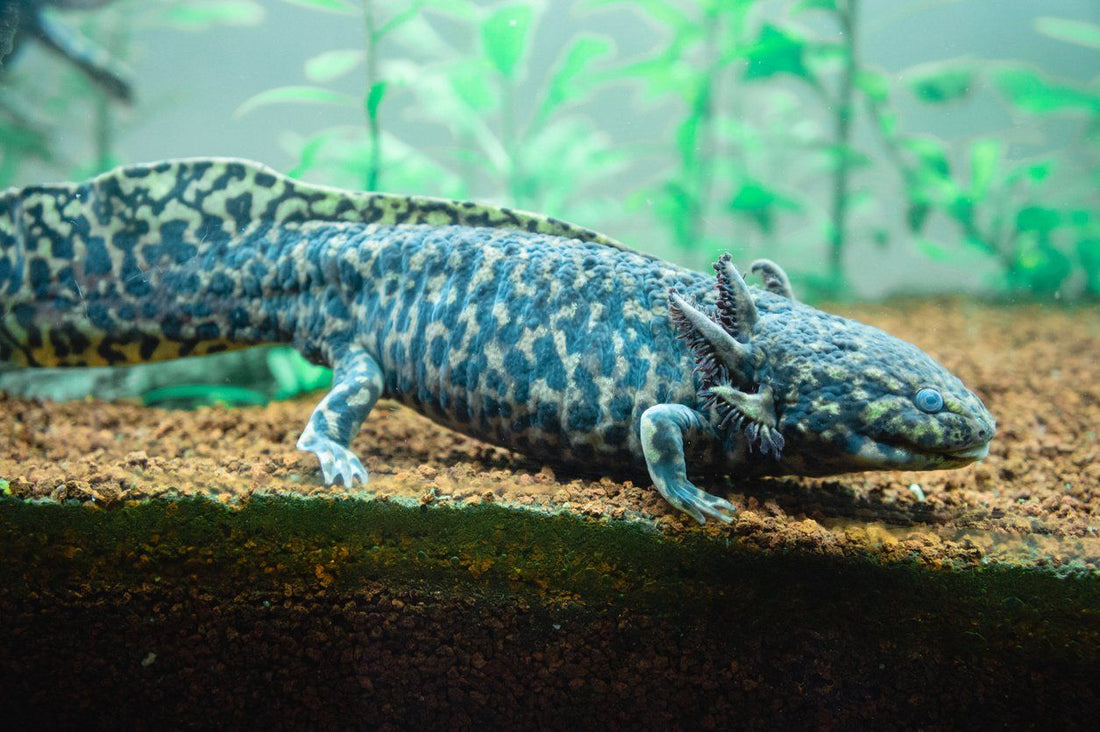Axolotls (Ambystoma mexicanum) are 10-14” long, fully-aquatic amphibians. They are native to Mexico, and can only be found in the cool, muddy water of Lake Xochimilco and Lake Chalco. Axolotls are very successfully bred in captivity, but they’re actually critically endangered in the wild.
Axolotls have smooth skin, a robust body, wide mouth, feathery gills, and a large vertical fin on their tail. Coloring is generally mottled green/tan and brown/black, although other colors and patterns are available in captivity. One thing that makes axolotls particularly unique among amphibians is that they keep their “larval” appearance for life, never metamorphosing to live on land!
Axolotls are considered to be fairly easy to care for, making them beginner-level amphibians. However, caring for them is more like keeping fish than keeping a traditional salamander. When cared for properly, axolotls can live 10-15+ years.
Minimum terrarium size for axolotls
The absolute minimum aquarium size for a single axolotl is 30”L x 12”W x 12”H (20 gallons) with a lid to prevent leaping. Of course, larger is always better!
Cohabitation (keeping multiple axolotls in one enclosure) is not recommended, but can be done. 10 gallons of tank size would need to be added for each additional axolotl. We recommend only doing so if you are familiar with the species already.
Do axolotls need UVB?
Axolotls do not need UVB lighting, but it is helpful to install a shielded ~6500K LED light fixture above the aquarium. You’ll need it to help any live plants thrive, and it also helps create a clear day/night cycle. Most keepers follow a 12-hour on and 12-hour off lighting schedule, but you can choose a schedule that follow the sun. This means, more light on during the summer and less light on during the winter.
Best temperature for axolotls
Like other amphibians, axolotls are cold-blooded, which means that they rely on external temperatures to manage their own body temperature and metabolism. These are cold-water creatures, so they do best with water temps between 60-65°F.
You can keep your axolotl’s tank cool by maintaining a cool room temperature, or you can use a water chiller. Axolotls get heat stressed easily, so this is a very important piece of equipment! You can use an aquarium thermometer to keep tabs on your aquarium temps.
Recommended water quality for axolotls
Although axolotls like stagnant water, that doesn’t mean they like dirty water. Dirty water will make your pet sick. You can completely change the water every week, but it’s easier to use a low flow aquarium filter. Make sure it’s low-flow for minimal water disturbance — a strong current will stress your axolotl! In addition, place a stone or other décor under the filter’s outflow to diffuse the current.
We recommend to perform 20-30% water changes every week to further maintain water quality. Any water added to the aquarium should be treated with dechlorinator like Zoo Med Reptisafe to prevent harmful chemicals from being introduced to your axolotl’s habitat. You can also consider Aqua-Safe Plus, API, or SeachemPrim. The acceptable water parameters you want are Ammonia: 0ppm, Nitrites: 0ppm (1ppm or more of either is lethal), Nitrates: 20-40ppm (avoid anything higher as it is toxic), pH: 6.8-7.8. Do not use distilled water or untreated tap water.
Scrub any algae buildup off the glass with a magnetic glass scrubber.
Best substrate for axolotls
Although substrate isn’t necessary to an axolotl aquarium, it’s good for making the enclosure more attractive. More importantly, it adds a source of environmental enrichment for the axolotl. If your axolotl is under 4", we recommend not using a substrate at all due to a high risk of ingestion and injury. Because impaction is a potential hazard even for older axolotls, we recommend a fine-particled, clean sand, like Exo Terra Riverbed Sand. Fine, natural sand will not cause harm to an older axolotl. Just be sure it's not crushed rock sand. Use a siphon regularly to keep the sand clean.
How to decorate an axolotl aquarium
A bare enclosure makes for a bored axolotl, reducing its quality of life. Keep your pet entertained and engaged with its environment with the strategic use of décor items that encourage it to exercise natural behaviors.
Décor options for axolotls include:
- mopani wood
- large rocks
- live or artificial plants
- pre-made hides/caves
- artificial ornaments
Make sure your axolotl has access to covered areas for when it wants privacy.
What to feed to an axolotl
Axolotls are carnivorous, which means that they need to eat whole animal prey in order to get the right nutrition. We recommend juveniles (2"-6" long) be fed daily, and adults 2-3x/week. Offer as much food as they will eat within ~10 minutes, and clean up any excess at the end.
Food options for axolotls:
- Blackworms
- Bloodworms
- Brine shrimp/Cherry shrimp/Ghost shrimp
- Earthworms (chopped)
- Fish
- Tubifex worms
- Mealworms (treat)
- Waxworms (treat)
- Black soldier fly larvae (treat)
- Salmon pellets
Regularly offer appropriate commercial diets like Omega One Newt & Salamander Pellets, Hikari Sinking Carnivore Pellets, or Tetra Reptomin as part of the rotation. This helps ensure that your axolotl gets enough vitamins and minerals.
Can you handle your axolotl?
No. We do not recommend handling your axolotl. Amphibians generally don’t appreciate petting and handling in the same way that dogs and cats do, and axolotls in particular are a hands-off pet.
*This care sheet contains only very basic information. Although it’s a good introduction, please further your research with high-quality sources. The more you know, the better you will be able to care for your pet!











